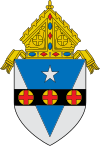J. Carroll McCormick
Joseph Carroll McCormick | |
|---|---|
| Bishop of Scranton Titular Bishop of Ruspae | |
 Rev. A. Paul Lambert and Bishop McCormick celebrating Golden Jubilee of Saint Philomena's Church (Lansdowne) (May 2, 1948) | |
| See | Diocese of Scranton |
| In office | 1966-1983 |
| Predecessor | Jerome Daniel Hannan |
| Successor | John Joseph O'Connor |
| Orders | |
| Ordination | July 10, 1932 by Dennis Joseph Dougherty |
| Consecration | April 23, 1948 by Dennis Joseph Dougherty |
| Personal details | |
| Born | December 15, 1907 |
| Died | November 2, 1996 (aged 89) |
| Denomination | Roman Catholic |
| Education | St. Charles Borromeo Seminary Pontifical Roman Seminary |
Joseph Carroll McCormick (December 15, 1907 – November 2, 1996) was an American prelate of the Roman Catholic Church who served as bishop of the Diocese of Altoona-Johnstown in Pennsylvania (1960–1966) and bishop of the Diocese of Scranton in Pennsylvania (1966–1983).
In a 2018 grand jury report, McCormick was criticized for his mishandling of sexual abuse allegations against priests when he was Bishop of the Diocese of Scranton.
Biography
[edit]Early life
[edit]McCormick was born in Philadelphia, Pennsylvania, on December 15, 1907. He studied at St. Charles Borromeo Seminary in the Overbrook section of Philadelphia and at the Pontifical Roman Seminary in Rome.
Priesthood
[edit]McCormick was ordained to the priesthood for the Archdiocese of Philadelphia by his uncle,[1] Cardinal Dennis Dougherty, on July 10, 1932.[2] McCormick served as vice-chancellor, and later chancellor (1936-1944), of the archdiocese. On June 24, 1940, while serving as Chancellor, McCormick offered the benediction at the closing of the second session of the 1940 Republican National Convention in Philadelphia.[3] He became pastor of St. Stephen's Parish in Philadelphia in 1944.
Auxiliary Bishop of Philadelphia
[edit]On January 11, 1947, McCormick was appointed as an auxiliary bishop of the Archdiocese of Philadelphia and as titular bishop of Ruspae by Pope Pius XII.[2] He received his episcopal consecration on April 23, 1947, from Cardinal Dougherty, with Bishops Hugh L. Lamb and Eugene J. McGuinness serving as co-consecrators.[2]
Bishop of Altoona-Johnstown
[edit]McCormick was named Bishop of the Diocese of Altoona-Johnstown on June 25, 1960, by Pope John XXIII. McCormick attended the Second Vatican Council from 1962 to 1965.[2]
Bishop of Scranton
[edit]McCormick was appointed Bishop of the Diocese of Scranton by Paul VI on March 4, 1966. [2]
Retirement and legacy
[edit]On February 15, 1983, Pope John Paul II accepted McCormick's letter of resignation as Bishop of Scranton.[2] He died on November 2, 1996, at age 89.[4][5][6]
In 2018, a grand jury investigating the handling of sexual abuse cases in Pennsylvania by the Catholic Church was released. The report described several instances in the Diocese of Scranton in which parents, a police officer and other clergy reported sexual assault or inappropriate behaviors by priests to the diocese. McCormick never notified parishioners or authorities about these allegations, but either dismissed them or reassigned the offending priests to different parishes.[4]
On August 21, 2018, King's College in Wilkes-Barre, Pennsylvania announced that they were removing McCormick's name from the building housing the chapel and the campus ministry. This was in reaction to revelations that McCormick had protected priests accused of sexually abusing children.[6] The University of Scranton also announced that it was renaming its McCormick Hall due to the same reasons as King's College.[5]
References
[edit]- ^ "His Eminence Dennis Cardinal Dougherty". The Bishops of Philadelphia. Archived from the original on 2013-02-22. Retrieved 2009-08-18.
- ^ a b c d e f "Bishop Joseph Carroll McCormick". Catholic-Hierarchy.org.[self-published source]
- ^ Official Report of the Proceedings of the 22nd Republican National Convention, published by the Republican National Committee (1940), p. 40
- ^ a b Report Grand Jury on sexual abuse in six dioceses in Pennsylvania, 2018
- ^ a b "University of Scranton stripping Scranton bishops' names from buildings", from The Scranton Times-Tribune
- ^ a b "Bishop’s Name to be Removed from King’s College Building"



